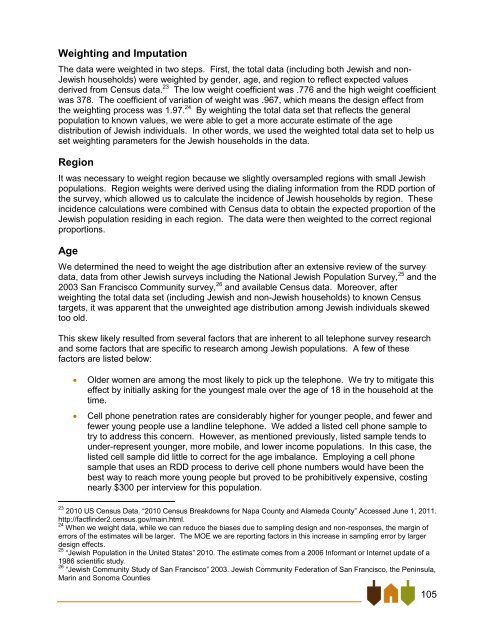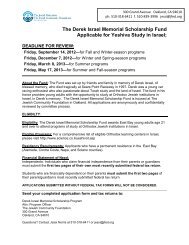East Bay Jewish Community Study - Jewish Federation of the ...
East Bay Jewish Community Study - Jewish Federation of the ...
East Bay Jewish Community Study - Jewish Federation of the ...
Create successful ePaper yourself
Turn your PDF publications into a flip-book with our unique Google optimized e-Paper software.
Weighting and Imputation<br />
The data were weighted in two steps. First, <strong>the</strong> total data (including both <strong>Jewish</strong> and non-<br />
<strong>Jewish</strong> households) were weighted by gender, age, and region to reflect expected values<br />
derived from Census data. 23 The low weight coefficient was .776 and <strong>the</strong> high weight coefficient<br />
was 378. The coefficient <strong>of</strong> variation <strong>of</strong> weight was .967, which means <strong>the</strong> design effect from<br />
<strong>the</strong> weighting process was 1.97. 24 By weighting <strong>the</strong> total data set that reflects <strong>the</strong> general<br />
population to known values, we were able to get a more accurate estimate <strong>of</strong> <strong>the</strong> age<br />
distribution <strong>of</strong> <strong>Jewish</strong> individuals. In o<strong>the</strong>r words, we used <strong>the</strong> weighted total data set to help us<br />
set weighting parameters for <strong>the</strong> <strong>Jewish</strong> households in <strong>the</strong> data.<br />
Region<br />
It was necessary to weight region because we slightly oversampled regions with small <strong>Jewish</strong><br />
populations. Region weights were derived using <strong>the</strong> dialing information from <strong>the</strong> RDD portion <strong>of</strong><br />
<strong>the</strong> survey, which allowed us to calculate <strong>the</strong> incidence <strong>of</strong> <strong>Jewish</strong> households by region. These<br />
incidence calculations were combined with Census data to obtain <strong>the</strong> expected proportion <strong>of</strong> <strong>the</strong><br />
<strong>Jewish</strong> population residing in each region. The data were <strong>the</strong>n weighted to <strong>the</strong> correct regional<br />
proportions.<br />
Age<br />
We determined <strong>the</strong> need to weight <strong>the</strong> age distribution after an extensive review <strong>of</strong> <strong>the</strong> survey<br />
data, data from o<strong>the</strong>r <strong>Jewish</strong> surveys including <strong>the</strong> National <strong>Jewish</strong> Population Survey, 25 and <strong>the</strong><br />
2003 San Francisco <strong>Community</strong> survey, 26 and available Census data. Moreover, after<br />
weighting <strong>the</strong> total data set (including <strong>Jewish</strong> and non-<strong>Jewish</strong> households) to known Census<br />
targets, it was apparent that <strong>the</strong> unweighted age distribution among <strong>Jewish</strong> individuals skewed<br />
too old.<br />
This skew likely resulted from several factors that are inherent to all telephone survey research<br />
and some factors that are specific to research among <strong>Jewish</strong> populations. A few <strong>of</strong> <strong>the</strong>se<br />
factors are listed below:<br />
<br />
<br />
Older women are among <strong>the</strong> most likely to pick up <strong>the</strong> telephone. We try to mitigate this<br />
effect by initially asking for <strong>the</strong> youngest male over <strong>the</strong> age <strong>of</strong> 18 in <strong>the</strong> household at <strong>the</strong><br />
time.<br />
Cell phone penetration rates are considerably higher for younger people, and fewer and<br />
fewer young people use a landline telephone. We added a listed cell phone sample to<br />
try to address this concern. However, as mentioned previously, listed sample tends to<br />
under-represent younger, more mobile, and lower income populations. In this case, <strong>the</strong><br />
listed cell sample did little to correct for <strong>the</strong> age imbalance. Employing a cell phone<br />
sample that uses an RDD process to derive cell phone numbers would have been <strong>the</strong><br />
best way to reach more young people but proved to be prohibitively expensive, costing<br />
nearly $300 per interview for this population.<br />
23 2010 US Census Data. ―2010 Census Breakdowns for Napa County and Alameda County‖ Accessed June 1, 2011.<br />
http://factfinder2.census.gov/main.html.<br />
24 When we weight data, while we can reduce <strong>the</strong> biases due to sampling design and non-responses, <strong>the</strong> margin <strong>of</strong><br />
errors <strong>of</strong> <strong>the</strong> estimates will be larger. The MOE we are reporting factors in this increase in sampling error by larger<br />
design effects.<br />
25 ―<strong>Jewish</strong> Population in <strong>the</strong> United States‖ 2010. The estimate comes from a 2006 Informant or Internet update <strong>of</strong> a<br />
1986 scientific study.<br />
26 ―<strong>Jewish</strong> <strong>Community</strong> <strong>Study</strong> <strong>of</strong> San Francisco‖ 2003. <strong>Jewish</strong> <strong>Community</strong> <strong>Federation</strong> <strong>of</strong> San Francisco, <strong>the</strong> Peninsula,<br />
Marin and Sonoma Counties<br />
105




